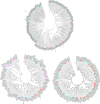Genomic Analysis of Detoxification Supergene Families in the Mosquito Anopheles sinensis
- PMID: 26588704
- PMCID: PMC4654499
- DOI: 10.1371/journal.pone.0143387
Genomic Analysis of Detoxification Supergene Families in the Mosquito Anopheles sinensis
Abstract
Anopheles sinensis is an important malaria vector in China and other Southeast Asian countries, and the emergence of insecticide resistance in this mosquito poses a serious threat to the efficacy of malaria control programs. The recently published An. sinensis genome and transcriptome provide an opportunity to understand the molecular mechanisms of insecticide resistance. Analysis of the An. sinensis genome revealed 174 detoxification genes, including 93 cytochrome P450s (P450s), 31 glutathione-S-transferases (GSTs), and 50 choline/carboxylesterases (CCEs). The gene number was similar to that in An. gambiae, but represented a decrease of 29% and 42% compared with Aedes aegypti and Culex quinquefasciatus, respectively. The considerable contraction in gene number in Anopheles mosquitoes mainly occurred in two detoxification supergene families, P450s and CCEs. The available An. sinensis transcriptome was also re-analyzed to further identify key resistance-associated detoxification genes. Among 174 detoxification genes, 124 (71%) were detected. Several candidate genes overexpressed in a deltamethrin-resistant strain (DR-strain) were identified as belonging to the CYP4 or CYP6 family of P450s and the Delta GST class. These generated data provide a basis for identifying the resistance-associated genes of An. sinensis at the molecular level.
Conflict of interest statement
Figures



References
-
- WHO. World Malaria Report. 2014.
-
- Harbach RE. The classification of genus Anopheles (Diptera: Culicidae): a working hypothesis of phylogenetic relationships. Bulletin of entomological research. 2004;94(6):537–53. . - PubMed
Publication types
MeSH terms
Substances
Grants and funding
LinkOut - more resources
Full Text Sources
Other Literature Sources
Research Materials

